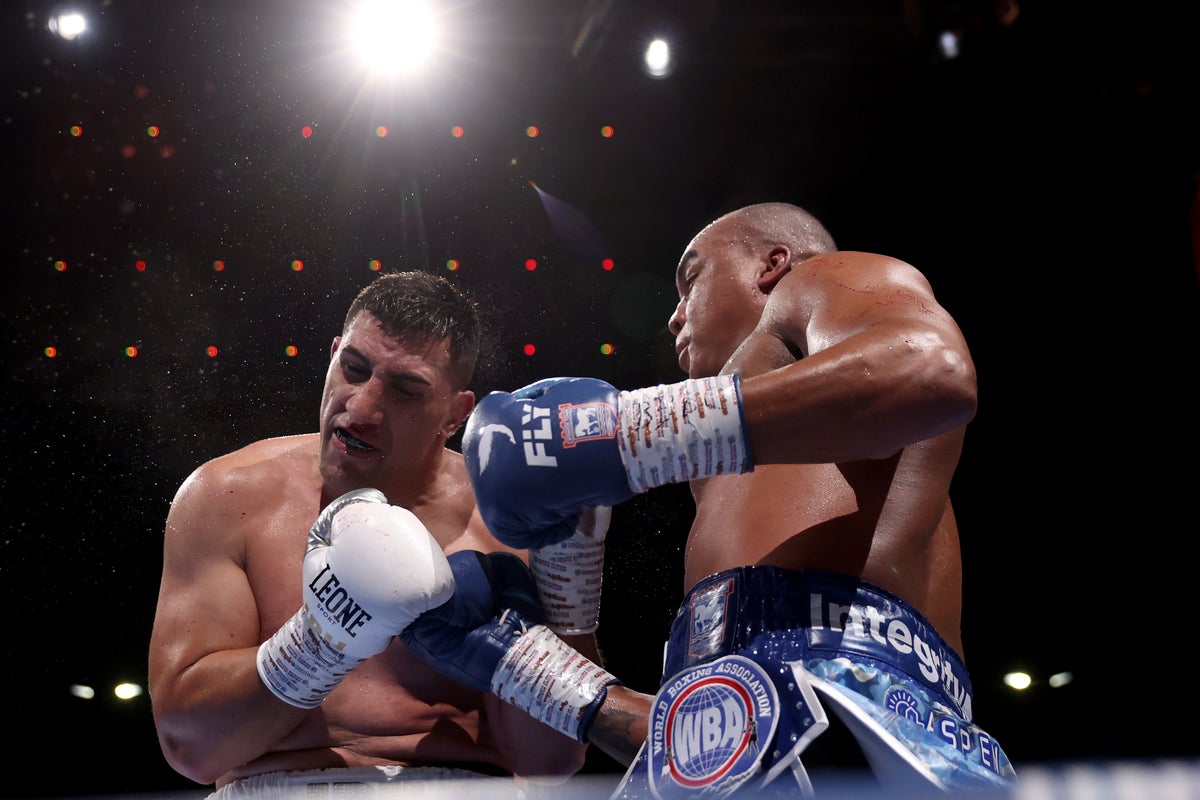Long, slow runs are in vogue right now. “Zone 2” conditioning, as it is now widely known, has been linked to all manner of health and performance benefits, from boosting cardiac output to increasing the quantity and efficiency of mitochondria – the powerhouses of muscle cells.
These are desirable traits for a boxer – no athlete would argue against having a more efficient fuelling system during a fight. But is zone 2 the most efficient way to achieve these ends? Arguably not.
“Zone 2 does offer these benefits, but you need eight to 10 hours on the road, which you just don’t have time for [as a boxer] – it’s about being efficient with what you have,” says Dr Rhys Morris, senior lecturer at Nottingham Trent University and strength and conditioning coach specialising in boxing.
This opinion is reinforced by Danny Wilson, founder of coaching company Boxing Science and strength and conditioning coach to Mirafit athlete Fabio Wardley.
“Punch outputs are lower in the heavyweight division – this means that a lot of heavyweights go for longer, slower conditioning methods,” he says. “However, they need quite the opposite: to become conditioned to produce high amounts of force repeatedly.
“So, for our conditioning, we perform very short, intense sessions that condition power-endurance.”
Below, you can find an example of a session Wilson uses with Wardley to achieve this.
Fabio Wardley’s ‘brutal’ 14-minute conditioning workout for power endurance
Complete four rounds of the sequence below:
- 30 seconds maximum effort
- Three minutes of recovery
“[Our conditioning work] includes a brutal 30 seconds max-out effort session,” says Wilson. “When boxers work that hard, they only need to perform four repetitions, with three minutes of rest between each rep.”
The key here is that, to trigger fitness improvements, the work periods must be maximal efforts – you cannot coast any reps. This stimulus can be achieved through any modality, be that running, cycling on an exercise bike, using a rowing machine, burpees or lighter weighted conditioning exercises like thrusters.
The common denominator is that your chosen activity has to let you move fairly quickly and take your heart and lungs to a testing place. For this reason, activities such as skipping are unlikely to cut it.
It is also worth considering your recovery. The extra load put through your body during burpees and thrusters, as well as the repeated braking forces from running, will fatigue the body and could interfere with your sport-specific training. For this reason, a fan bike is a popular option among boxing strength and conditioning coaches.
Read more: The expert-approved workout that can help boxers build fight-ready fitness
What else does Fabio Wardley do in the gym to support his performance?
“A key component of punching power is the kinetic chain,” says Wilson. “This is how power is transferred from the foot all the way through to the fist.
“We need the body to be co-ordinated so it can work sequentially, and we also need to mak sure there are no ‘weaknesses’ in the chain.”
To achieve this, every one of his strength and conditioning sessions with Wardley contains a combination of lower body, upper body pushing, upper body pulling, single-leg and core exercises.
“Rep ranges depend on the training phase, but we normally go for between three and eight repetitions,” says Wilson “This is a relatively low volume, allowing us to focus more on force and power development.”
Lower body training
One of Wardley’s go-to exercises for the lower body is the trap bar deadlift. This movement places less strain on the lower back than a traditional deadlift, but still allows an athlete to recruit all the major muscles in the legs to move large loads.
“To become explosive, we need to train maximum strength, speed and power,” says Wilson. “We perform trap bar deadlifts as it’s a key compound movement for maximum strength, and then we perform jumps for speed and power.
“For the trap bar deadlifts, we attach a GymAware device to give feedback on lifting velocities. This makes our training more precise. It encourages Fabio to lift the bar faster, making our strength training more explosive.”
Wardley also likes to use banded weighted squats to improve strength and power generation through the legs. This ensures a strong start point for the kinetic chain, which can translate to a more powerful punch.
“I tend to prioritise explosive movements that can enhance power and strength, translating directly into the ring,” he says. “The banded weighted squat is a challenging but rewarding exercise that forces me to stay explosive all the way through the movement, because the resistance increases as I drive upward. Strong and explosive legs are essential in the ring, helping me maintain strong balance and footwork throughout a fight.”
Upper body training
For upper body pressing, Wardley favours the explosive landmine press.
“It’s not only great for building and maintaining strength, it also enhances power, which is exactly what I need to land a knockout blow,” he says.
Striking a balance
The most difficult part of any pre-fight workout is finding the right intensity of training to trigger adaptations without pushing himself to the point of injury, Wardley says.
“During fight camp, each session has to count, and I’m constantly aiming to sharpen my strength and explosiveness,” he explains. “It’s about being smart and combining intense workouts with substantial recovery elements. After all, the last thing any boxer wants is to be out injured on fight night.”
Another key element of Wardley’s Parker preparation is his recovery. Performance improvements are far more likely to occur when a fighter is able to train to their full potential, and that means bringing the best version of themselves to the gym and ring each day.
“As a professional athlete, I understand the importance of recovery-focused days, so I prioritise them accordingly,” he says. “On days with minimal activity, I make use of my sauna, which not only helps me relax but also boosts recovery by reducing muscle tension between workouts.
“Additionally, I love a massage on recovery days, helping prevent tightness which could lead to injury. Aside from that, I generally just try to switch off and enjoy my rest days.”
Feeling fight ready
Motivation has never been an issue for Wardley: “I love what I do, and performing at the top of my game is what keeps me on track.”
However, he says having the right people around him is a significant piece of the puzzle that is boxing success.
“Thankfully, I have a supportive group of friends and family who keep me grounded and remind me why I’m doing it on more challenging days,” he says. “A supportive team is so important, and having the right people around you can really make a difference. At the end of the day, I know what’s waiting for me on fight night, and that’s all the motivation I need.”
Wardley also implicitly trusts his coaching team to ensure he feels fight-ready for Parker on Saturday night.
“My training camp is designed to give me all the tools I need to be successful on fight night, with the camp mapped out to ensure I peak on the week of my fight,” he says.
“As a result, I always feel ready as I trust in my training camp and can see visible progress in strength, movement and explosiveness.”
Read more: The daily non-negotiables that transformed Conor Benn’s health and mindset in 70 days
DAZN is the home of combat sports, broadcasting over 185 fights a year from the world’s best promoters, including Matchroom, Queensberry, Golden Boy, Misfits, PFL, BKFC, GLORY and more. An Annual Saver subscription is a one-off cost of £119.99 / $224.99 (for 12 months access), that’s just 64p / $1.21 per fight.
There is also a Monthly Flex Pass option (cancel any time) at £24.99 / $29.99 per month. A subscription includes weekly magazine shows, comprehensive fight library, exclusive interviews, behind-the-scenes documentaries, and podcasts and vodcasts.
For pricing in your country, more information and to sign up, click here.









